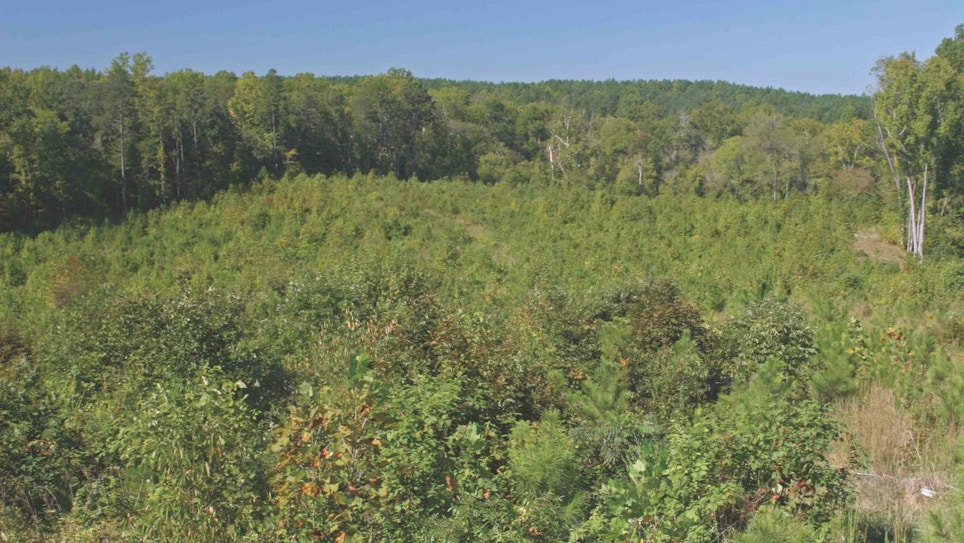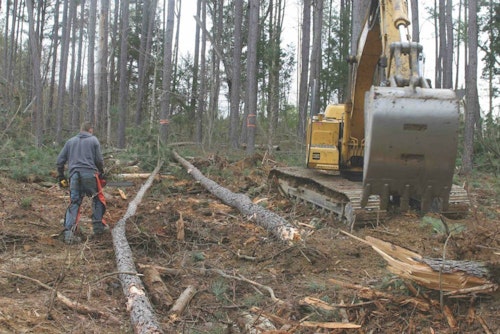
Cutting a large section of mature woods not only results in a large stand of high-quality food, but it also creates outstanding bedding cover for your whitetail deer herd.
Creating and managing high-quality habitat on your land is challenging. However, managing the deer that utilize your developed habitat is even more difficult. Any time those deer step onto your neighbor’s property, your efforts can go down the drain.
The solution? Keep those whitetails from leaving. How? By providing high-quality habitat so they will spend more time on your land and less on your neighbor’s.
You certainly can’t keep every buck in the neighborhood from hopping your fence or stepping over your property line. Even if you manage hundreds or even thousands of acres, bucks like to wander, especially during the breeding season. But every minute matters. The longer a deer stays on your land, the less likely it will end up in your neighbor’s freezer.
Don’t worry. Everyone can take a few simple steps to encourage bucks — and does — to stick around a little longer. Even hunters who own or manage just a few acres can make their land a little more attractive.
Bedding Areas
The easiest step to habitat improvement is the creation of bedding areas. By giving bucks and does a place to hide during the day, they are much more likely to stay on your land longer. Instead of catching them crossing onto your land from the neighbor’s during legal shooting light, they will already be on your property.
“Ground-level cover that is thick provides a sense of security,” said Quality Deer Management Association Biologist Matt Ross. “Deer find those places and use them. As bucks age, their home ranges shrink, so they tend to spend more time in places where they feel secure.”
What makes good bedding cover? Think thick. Dense cover that is virtually impossible for a human to walk through is ideal whitetail bedding cover. Deer can hear danger walking through that cover, and they can slip out the back door without being seen.
“Thinning mature trees or even clear-cutting an area is a sure way to create good bedding cover,” Ross said. “By removing the canopy of shade, you allow sunlight to reach the ground, and that stimulates a wide range of plant growth. In a couple of years, you will have super-thick cover from the stump sprouts and a variety of other plants that grow.”

Allowing fields to grow into a jungle of grasses, vines, shrubs and young trees is also a great way to create bedding areas. Instead of mowing, spray a field with glyphosate in the early spring or late fall to kill off cool-season grasses such as fescue. Then leave the field alone. In just a few short years, it will grow into a mix of blackberry thickets, native grasses and a variety of shrubs and other plants. Left alone, those plants will be so thick that deer will find security within the cover and use it as a bedding area. Many of the plants growing in that field will provide high-quality deer forage, too. An added bonus: Turkeys will nest in that same cover.
There is no ideal ratio for the amount of bedding cover on a tract of land. Generally, though, Ross says more is better. “You want to be able to hunt it, of course, so you don’t want every acre to be thick cover, but the more places they have to hide, the more likely they will stay on or close to your land,” he said. “More bedding cover also means more deer, in general. Mature bucks tend to be loners, so if you can create several separate bedding areas across your property, you may attract more mature bucks.”
No Hunting Allowed
Providing high-quality bedding habitat is a great first step, but you also have to avoid those places to keep deer around. In other words, you can’t go anywhere near them. By creating a refuge on your property, you give deer a safe space, a place they can go where they never get bumped by hunters or even catch a whiff of human scent. It takes only one close call to send them onto your neighbor’s land. Mature bucks in particular have a low tolerance for humans and can take days or even weeks to return to a bedding area if they were spooked from it.
Creating sanctuaries and abiding to the “no trespassing” rules can be challenging on smaller tracts, but it is critical tactic if you want to keep bucks from taking up residence on your neighbor’s land. Don’t hunt close to them. Don’t even walk around them, especially if the wind is pushing your scent into the cover. There is no set distance, but the farther you can stay away from those refuges, the better.
Hunt Less
One sure way to keep bucks on your land is to spend less time hunting. That may sound counterproductive, but lots of research using GPS tracking collars has shown how hunting pressure impacts whitetail activity. Basically, it pushes them into unpressured areas, turns them nocturnal and makes them harder to hunt.
That doesn’t mean you should turn your entire property into a refuge that never gets hunted. Instead, simply keep pressure to a minimum and never hunt close to your designated bedding areas or other refuges.
One study conducted in South Carolina found that just 12 hours of hunting pressure would push bucks away from a stand site. Repeated use of a stand for several days kept deer away even longer. That could mean they end up on someone else’s property if you hunt too much.
How much is “too much?” The South Carolina study found that bucks will return to a stand area after it rested 3 or 4 days. However, even with several days of rest, bucks were less likely to use an area once it had been hunted.
What About Food Plots?
Providing high-quality forage during the fall and winter may seem like a sure way to keep bucks on your land, but it may not be. Deer have to eat, of course, but once bucks catch a whiff of human scent in their woods, they may not visit a food plot during legal hunting hours. Or as the South Carolina study found, they may avoid plots that have been hunted and search for other food sources, at least for a few days.
There’s nothing wrong with planting a patch of turnips or clover on your land, especially if you have lots of room. However, Ross says if space is limited, opt for increasing the amount and quality of bedding cover instead. Deer will camp out on your land during the day, leave right at dark and return in the first few minutes of legal shooting light. Such a schedule allows you the chance to intercept deer on their way to and from that food.
“Food typically isn’t a limiting factor in good habitat,” Ross said. “They will travel a long way to get to food, but that activity is often at night during hunting season, so if I had to choose, I would opt for bedding cover over a food plot.”
There is one time a food plot can be the ticket to keeping bucks around: the whitetail breeding season. Because does and fawns are more likely to visit a food plot during daylight hours, it only makes sense bucks will be there during the rut, too.

Small Tract Strategies
It is much more difficult to keep bucks on small tracts of land no matter what time of year it is, agrees Ross, but that shouldn’t stop you from trying. Any amount of bedding cover, no matter how small, can entice at least one buck to spend more time on your land.
The best thing you can do, however, is meet the neighbors and entice them to adopt similar land management strategies. Forming a cooperative for the benefit of whitetails doesn’t have to require a legally binding agreement. It just needs to be a mutual understanding of some common deer hunting goals. If one goal is keeping young bucks alive another year or two, convincing neighboring landowners to create more bedding cover can pay dividends.
“If you can get five neighbors with 20 acres to create more or better bedding cover, you automatically increase the odds of a buck staying on that combined acreage,” Ross said. “That may also help fawn survival. The harder it is for a predator to find a fawn, the more likely that fawn will survive. Half those fawns will be bucks, so it is all tied together.”





